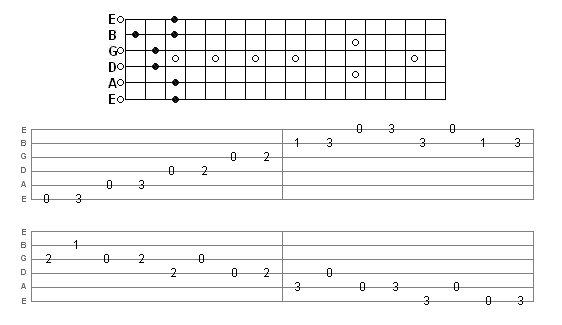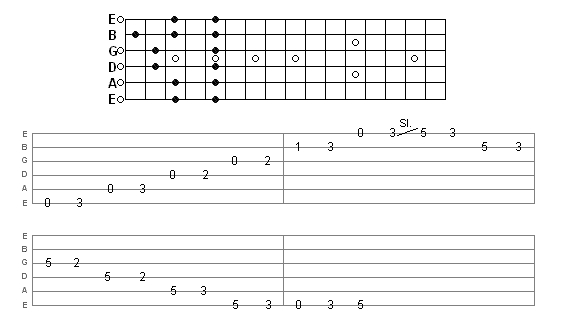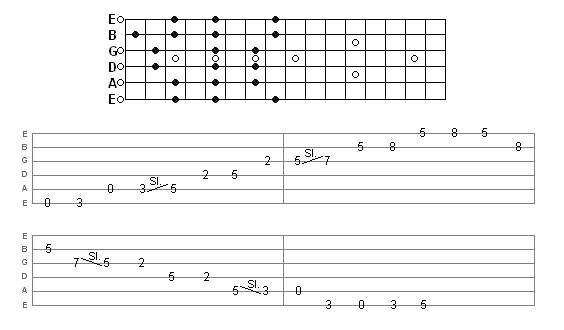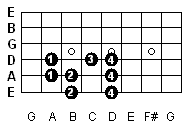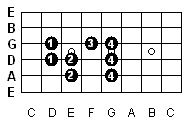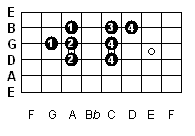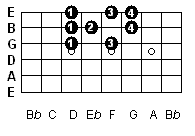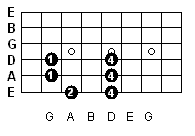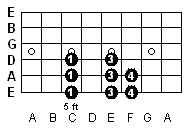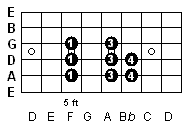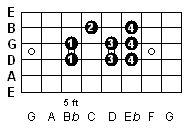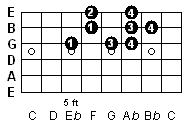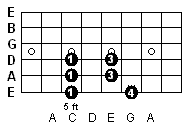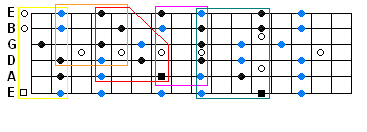Blog Archives
Using Minor Pentatonic Over Non-relative Major Chord Progression
Recently, I was messing around with different riffs while playing against some new backing tracks I found. I was playing around in the key of A major and the F# minor pentatonic just wasn’t sounding right to me. It was missing something. Oddly, at the moment, I had a melody pop in my head that sounded good with the backing track. As I started hammering it out on the guitar, I realized I was playing the A minor pentatonic over the A major chord progression and it sounded perfect!
As I played on, I couldn’t believe what I was hearing. This totally blew all the rules of music theory out the window as I should have been playing F#m over A or Am over C. I dug into it a little further and found something very interesting. A major and C major have all the same notes except three in common; F#, C#, and G#. Because of the rest of the notes being common, my ear couldn’t tell the difference. The three that were not in common added just enough tension that my ear wanted to hear so it sounded better with that tension than without.
Below is the riff I came up with. It’s a six bar version of the 12 bar blues progression. I recorded several different strummings with the same chords and played the riff against them all. None of them sounded like they didn’t belong together.
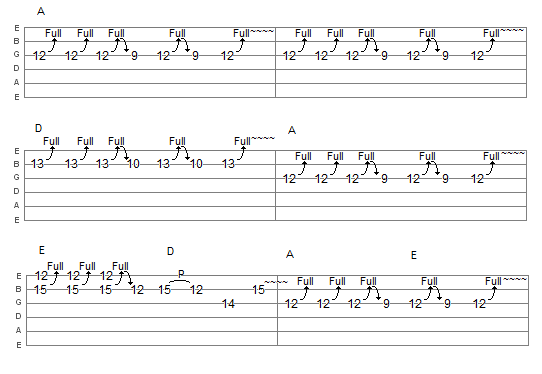
Give the riff a try. If you can, record the chord progression as I have labeled and play the riff against it. Or, try your own combinations. See if a C# minor pentatonic scale sounds good over a C# major chord progression. You may find, as I did, the possibilities are endless and it will give you a new sound.
Test Your Skills – Perfecting Your Technique (Part 2)
While teaching the pentatonic scales, it seems as though it leaves my students wondering “what next?” Well, here’s a few skill builders to show you why and how the pentatonic boxes connect. We’ll be in the key of C. To start, let’s take a look at the pentatonic box 3…or the E Phrygian scale.
Below is a simple skill builder starting at the top of the neck. Most instructors should tell you not to focus on playing scales from bottom to top in formation. While this one goes from bottom to top and back down again, it’s the way it comes back down that’s unique. Notice the pattern is in-line while going up the scale, but it’s altered coming down. This trains your mind to think…”outside ‘the box'”…excuse the pun.
One of the most difficult concepts to teach, as well as understand, is how the pentatonic boxes fit together. This next skill builder shows how to use a slide at the end to bring you from the E Phrygian scale to the G Mixolydian scale on the way back down.
Let’s take this a step further. First, we won’t be going up, we’ll be coming down. Second, we’ll be using the E Phrygian scale, the G Mixolydian scale, and the A Aeolian scale…or the minor pentatonic scale.
If you look at the fretboard diagram, you can see how we added the bottom part of each pentatonic to the previous one. This is because the bottom of each pentatonic is the top of the one we’re adding. In the example above, you can see where we transitioned between the scales by using slides. While this isn’t the perfect demonstration, it does show how you can merge three pentatonic scales together. Knowing your scale patterns and how they all fit together will help you play up and down the neck of the guitar with little effort.
Know Your Scales – Revisited
Here it is…the first lesson of the new year!!
Recently, one I was teaching one of my students their scales. This student had taken lessons from a different instructor, but was feeling like something was missing. I was teaching the major scale and how, if you remove the 4th and 7th notes, it becomes the beginning of the major pentatonic scale. He mentioned that it looks different than the major pentatonic that he was taught. That’s because the previous instructor, who had a degree in music and played in three different bands, had taught him the wrong thing.
Below are two versions of the major scale. Notice the numbers for the fingers to use, and that the patters are the same, just on different strings.
These next two images are of the same scale pattern, but, because of the orientation of the B string, you have to shift the fingering just a bit.
My student was amazed that you could use the same position across the neck of the guitar. He was only taught how to start on the E or the A string. If you truly want to learn to play guitar, you have to know where the notes are on the fretboard and you have to know your scales. In the image below, I showed him how removing the 4th and 7th notes produces the beginning of the major pentatonic. Look at this, then scroll up and look at the G scale above. See how it works?
Then, I explained to my student that what he was taught was the minor pentatonic. To start, I first showed him the above examples, then showed him how the minor scales look. Below are the first two minor scales. Again, same pattern, just different strings. Also note that the above patterns started on the 3rd fret, where the ones below start on the 5th. All of the patterns I’m showing you can be played up and down the neck of the guitar, but, for learning purposes, I chose to start them like I did.
As with the major scales, the minor scales also have to be adjusted when playing over the B string.
Here is where I showed him that he was truly learning the minor pentatonic scale. Instead of removing the 4th and 7th notes, we will be removing the 2nd and the 6th notes.
My student was completely surprised, but later told me that it makes perfect sense when you remove the notes to get the pentatonic.
My advice…practice these scales up and down the neck of the guitar. Not only will you be able to play them better when you do, but your soloing will improve as well as you’ll have a much better idea of where each scale can be played.
Guitar a la Modes
Most music is created off the top of the artist’s head, the rest is a collective brainstorm to produce a song that’s current with the times. Either way, many musicians don’t sit down and draw a song out like an outline for a business plan or a blueprint for a building, it just comes naturally. However, there is some planning and musical theory that goes into a song and part of it has to do with modes.
Modes are scales and chord progressions that are produced by moving the starting point of a scale or chord progression without changing its formula. Take, for instance, the C major scale (C, D, E, F, G, A, B, C). This orientation of the scale would be considered the Ionian mode, or major mode. This mode can be used in many forms of music. The chord progression for this mode would be C, Dm, Em, F, G, Am, Bdim, C.
If we move up one position in the scale, we get what’s called the Dorian mode. This is most commonly heard in jazz and jazz/rock where it’s used in soloing over minor seventh chords and sounds like the natural minor with a raised sixth. Nate Richards from Richards Guitar Studio has a video that discusses the Dorian mode more in detail and explains how it’s used in modern music. You can read more about it at Modes for Guitar – Example in Dorian. Notice nothing changes except the starting position. The scale is D, E, F, G, A, B, C, D and the chord progression is Dm, Em, F, G, Am, Bdim, C, Dm.
The third position will give us the Phrygian mode. You would typically hear this in flamenco music, which sounds like a natural minor with a flatted second. Again, nothing about the C major scale changed except the starting point, so the scale would be E, F, G, A, B, C, D, E and the chord progression would be Em, F, G, Am, Bdim, C, Dm, Em.
Building off of this theory, the rest of the modes can be briefly explained. The fourth position gives us the Lydian mode, which sounds like the major scale with the exception of the sharped fourth. This mode is used in jazz to solo over major seventh chords.
The fifth position gives us the Mixolydian mode, which also sounds like a major scale except for the flatted seventh. This is heard in a lot of folk music and modern rock music.
The sixth position is the Aeolian mode. Note that this is also the relative minor of the scale or chord progression. In this case, it would be the Am chord for the C progression.
The seventh position is theLocrian mode. It was avoided for many centuries because of it’s diminished chord preventing melodies to never truly come to rest. This is mostly heard in jazz soloing over minor seventh flat five chords.
Test these modes out next time you practice. Try an F Phrygian by starting on the third position of the D flat scale (Fm, Gb, Ab, Bbm, Cdim, Db, Ebm, Fm) or an D Mixolydian by starting on the fifth position of the G major scale (D, Em, F#dim, G, Am, Bm, C, D). The possibilities are nearly endless.


